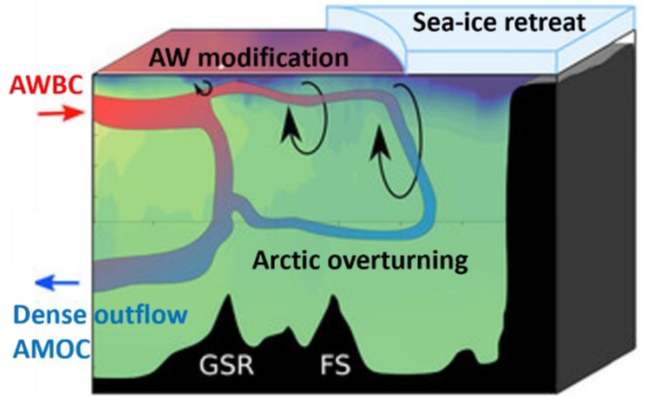ArMOC
Overturning circulation in the new Arctic
Main content
Project summary: The Arctic overturning circulation involves the production of water masses that are key to the global ocean circulation associated with the Atlantic Meridional Overturning Circulation (AMOC). Arctic climate is, however, rapidly changing, and it is currently not known how the Arctic overturning circulation is responding. A major source of dense water to the lower limb of the AMOC is Atlantic Water (AW) that gradually transforms to denser waters on its path along the Atlantic Water Boundary Current (AWBC) in the Nordic Seas and Arctic Ocean. The recent sea-ice retreat along the margins of the Arctic Ocean has partially uncovered the AWBC, exposing it to the atmosphere in winter and, hence, allowing further modification of the AW. As the transition towards a seasonally ice-free Arctic continues, enhanced water mass transformation can therefore be expected, leading to a possible strengthening of the Arctic overturning circulation. The Arctic overturning circulation could therefore be a stabilizing factor in a weakening AMOC, highlighting the importance of understanding its drivers and its response to climate change. ArMOC will accordingly provide:
- A comprehensive understanding of the entire AWBC system around the Nordic Seas and the Arctic Ocean from observations, including new, unique wintertime data from Argo floats, and high-resolution models (WP1).
- Novel insights on AW pathways and transformation within the Arctic Ocean, and whether these are expected to change under future global warming, through Lagrangian analysis with high- and low-resolution models (WP2).
- A step-change in our understanding of the Arctic overturning circulation in present and future climates by providing a first quantification using the approach of thermohaline streamfunctions (WP3).
Funding: FRIPRO, Research Council of Norway
Project period: 12.2023-05.2027
Project leader: Marius Årthun (UiB)
Project members:
UiB: Stefanie Semper (lead WP1), Jakob Dörr, Carlo Mans, Lars Henrik Smedsrud, Kjetil Våge
NERSC: Yanchun He (lead WP2), Helene R. Langehaug, Jiping Xie
NORCE: Aleksi Nummelin
International partners: Kristoffer Döös (Stockholm University, Sweden), Tom Haine (Johns Hopkins University, USA), Helen L. Johnson (University of Oxford, UK), Robert Pickart (Woods Hole Oceanographic Institution, USA)

